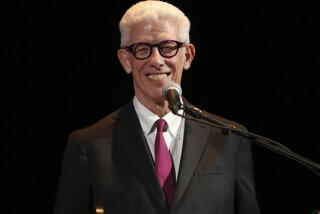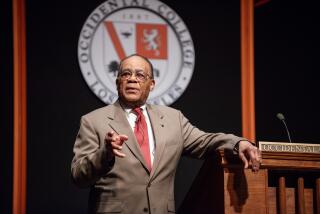Nobel laureate Richard Heck dies at 84; UCLA grad transformed organic chemistry
Richard Heck, a UCLA graduate who shared the Nobel Prize in 2010 in chemistry for designing a method of building complex molecules that has helped fight cancer, protect crops and make electronic devices, has died at his home in the Philippines. He was 84.
Heck, a professor emeritus at the University of Delaware, died Saturday from multiple organ failure after bouts with pneumonia, diabetes and liver cirrhosis, said Michael Nardo, his nephew, who had cared for Heck and his wife over the past decade.
Heck, whose interest in plants as a child led him to a career in chemistry, shared the Nobel Prize with Ei-ichi Negishi and Akira Suzuki. The Nobel Prize organization said his work in creating the “Heck reaction” was a transformative step in modern organic chemistry that aided drug development and DNA sequencing.
Born in Springfield, Mass., on Aug. 15, 1931, Heck moved with his family to Los Angeles when he was 8. He earned a doctorate in physical organic chemistry from UCLA in 1954 and later joined the faculty at the University of Delaware.
He retired to Manila in 1989 with his wife, Socorro Nardo-Heck, who died in 2012. The couple had no children.
Family members and fellow scientists paid tribute to Heck’s humility and simplicity despite his achievements. Wreaths and prayer cards from various scientific groups adorned a chapel in Manila where he was interred.
“He was very kind, very helpful to my family, very humble, very quiet,” Nardo said. “I hope his contributions to the chemical society and the whole world will be remembered.”
Alvin Culaba, a professor of De La Salle University in Manila, said Heck was “so simple and very human and very humble” and disliked public attention, despite his achievements.
In a 2012 speech given to accept an honorary degree from De La Salle University, Heck said he came from humble beginnings — the son of a department store salesman and a housewife in a suburb of Massachusetts. He said he became interested in nutrients and pigments in plants when as a boy, his family moved to a new home on a barren lot in Los Angeles.
“I had never thought the simple work of planting an empty yard would bloom and peak into an achievement of the noblest honor in the world of science,” he said.
“I find my meaning as a scientist in what I have been able to make of my country, in what I have been able to contribute to significantly better the lives of peoples across cultures and societies,” he said.
Heck and his co-winners designed the technique to bind together carbon atoms, a key step in assembling the skeletons of organic compounds used in medicine, agriculture and electronics.
The Nobel committee cited the technique as “one of the most sophisticated tools available to chemists today.”
Heck returned to UCLA in 2011 to accept the Glenn T. Seaborg Medal.
A Times staff writer contributed to this report.
More to Read
Start your day right
Sign up for Essential California for the L.A. Times biggest news, features and recommendations in your inbox six days a week.
You may occasionally receive promotional content from the Los Angeles Times.






